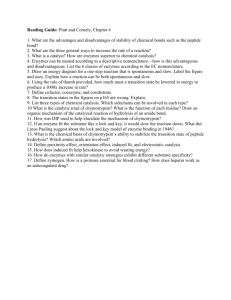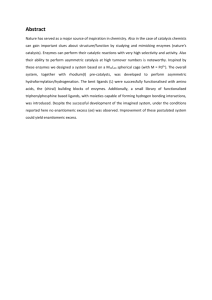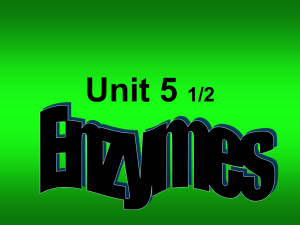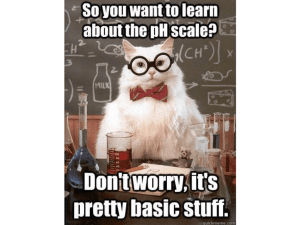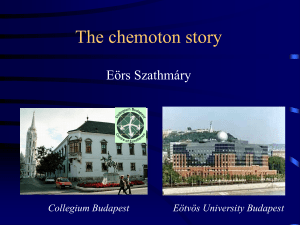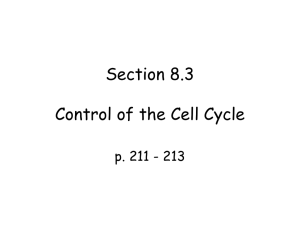Enzymes: Principles of Catalysis
advertisement
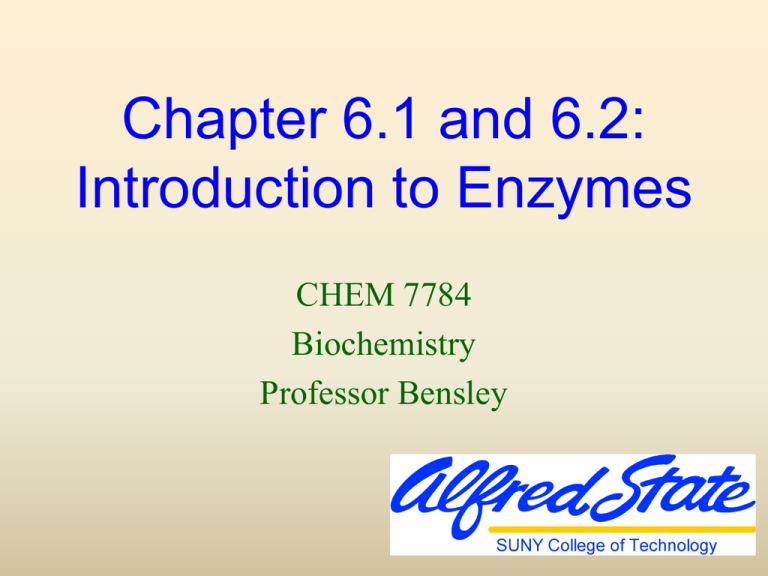
Chapter 6.1 and 6.2: Introduction to Enzymes CHEM 7784 Biochemistry Professor Bensley CHAPTER 6.1 and 6.2 Introduction to Enzymes and How Enzymes Work Today’s Objectives: (To learn and understand the) – Physiological significance of enzymes – Origin of catalytic power of enzymes – Chemical mechanisms of catalysis What are Enzymes? • Enzymes are catalytically active biological macromolecules • Most enzymes are globular proteins, however some RNA (ribozymes, and ribosomal RNA) also catalyze reactions • Study of enzymatic processes is the oldest field of biochemistry, dating back to late 1700s Why Biocatalysis? • • • • Higher reaction rates Greater reaction specificity Milder reaction conditions Capacity for regulation COO - COO NH2 O OH COO OH COO Chorismate mutase COO OOC O NH2 - - O COO COO • Metabolites have many potential pathways of decomposition OH - • Enzymes make the desired one most favorable Quiz Question 29 In order to function properly, some enzymes require the presence of an additional chemical component such as inorganic ions (Zn2+ or Fe2+). These inorganic ions are known as for enzymes. Quiz Question 30 Chymotrypsin is an enzyme that cleaves peptide bonds. It most likely, therefore, belongs to which class of enzymes? a) Transferases b) Ligases c) Isomerases d) Hydrolases Classes of enzymes 1. Oxidoreductases = catalyze oxidation-reduction reactions (Transfer of electrons) (NADH) 2. Transferases = catalyze transfer of functional groups from one molecule to another. 3. Hydrolases = catalyze hydrolytic cleavage (transfer of functional groups to water) 4. Lyases = catalyze removal of a group from or addition of a group to a double bond, or other cleavages involving electron rearrangement. 5. Isomerases = catalyze intermolecular rearrangement. 6. Ligases = catalyze reactions in which two molecules are joined. Enzymes named for the substrates and type of reaction E E S + S E+S k1 k-1 ES E k2 k-2 E+P + P Rate Acceleration • The enzyme lowers the activation barrier compared to the uncatalyzed aqueous reaction • In theory, the enzyme may also facilitate the tunneling through the barrier. This may be important for electrons. How to Lower G? 1. Enzymes organize reactive groups into proximity 2. Enzymes bind transition states best (Largely a ‡ H effect) Support for the Proximity Model • The rate of anhydride formation from esters and carboxylates shows a strong dependence on proximity of two reactive groups Support for TS Stabilization • Structure-activity correlations in chymotrypsin substrates Illustration of TS Stabilization Idea: Imaginary Stickase How is TS Stabilization Achieved? acid-base catalysis: give and take protons covalent catalysis: change reaction paths metal ion catalysis: use redox cofactors, pKa shifters electrostatic catalysis: preferential interactions with TS Acid-base Catalysis: Chemical Example Consider ester hydrolysis: O O + R O CH3 H-OH R O OH O + H + + R CH 3 OH OH CH3 Water is a poor nucleophile, and methanol is a poor leaving group Aqueous hydrolysis can be catalyzed either by acids or by bases Enzymes can do acid and base catalysis simultaneously Amino Acids in General Acid-Base catalysis Covalent Catalysis: Chemical Example O O CH3 O H3C O H2O slow O O H3C + - O - + + 2 H O O O CH3 O H3C fast O + N CH3 .. N .. H O O .. N H3C O + H3C O H - + N - CH3 OH + H + H3C O - • The anhydride hydrolysis reaction is catalyzed by pyridine, a better nucleophile than water (pKa=5.5). • Hydrolysis is accelerated because of charge loss in the transition state makes pyridine a good leaving group. Covalent Catalysis: In Enzymes • Proteases and peptidases – chymotrypsin, elastase, subtilisin – reactive serine nucleophile • Some aldehyde dehydrogenase – glyceraldehyde-3-phosphate dehydrogenase – reactive thiolate nucleophile • Aldolases and decarboxylases – amine nucleophile • Dehalogenases – carboxylate nucleophile NH 2 - HO O S - O N O N O N O N O
